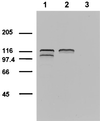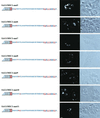Two conserved amino acid motifs mediate protein targeting to the micronemes of the apicomplexan parasite Toxoplasma gondii
- PMID: 10982850
- PMCID: PMC86287
- DOI: 10.1128/MCB.20.19.7332-7341.2000
Two conserved amino acid motifs mediate protein targeting to the micronemes of the apicomplexan parasite Toxoplasma gondii
Abstract
The micronemal protein 2 (MIC2) of Toxoplasma gondii shares sequence and structural similarities with a series of adhesive molecules of different apicomplexan parasites. These molecules accumulate, through a yet unknown mechanism, in secretory vesicles (micronemes), which together with tubular and membrane structures form the locomotion and invasion machinery of apicomplexan parasites. Our findings indicated that two conserved motifs placed within the cytoplasmic domain of MIC2 are both necessary and sufficient for targeting proteins to T. gondii micronemes. The first motif is based around the amino acid sequence SYHYY. Database analysis revealed that a similar sequence is present in the cytoplasmic tail of all transmembrane micronemal proteins identified so far in different apicomplexan species. The second signal consists of a stretch of acidic residues, EIEYE. The creation of an artificial tail containing only the two motifs SYHYY and EIEYE in a preserved spacing configuration is sufficient to target the surface protein SAG1 to the micronemes of T. gondii. These findings shed new light on the molecular mechanisms that control the formation of the microneme content and the functional relationship that links these organelles with the endoplasmic reticulum of the parasite.
Figures








References
-
- Achbarou A, Mercereau-Puijalon O, Autheman J M, Fortier B, Camus D, Dubremetz J F. Characterization of microneme proteins of Toxoplasma gondii. Mol Biochem Parasitol. 1991;47:223–233. - PubMed
-
- Adams J H, Hudson D E, Torii M, Ward G E, Wellems T E, Aikawa M, Miller L H. The Duffy receptor family of Plasmodium knowlesiis located within the micronemes of invasive malaria merozoites. Cell. 1990;63:141–153. - PubMed
-
- Aroeti B, Okhrimenko H, Reich V, Orzech E. Polarized trafficking of plasma membrane proteins: emerging roles for coats, SNAREs, GTPases and their link to the cytoskeleton. Biochim Biophys Acta. 1998;1376:57–90. - PubMed
Publication types
MeSH terms
Substances
Grants and funding
LinkOut - more resources
Full Text Sources
